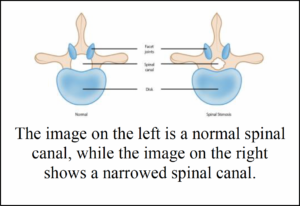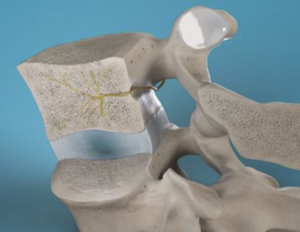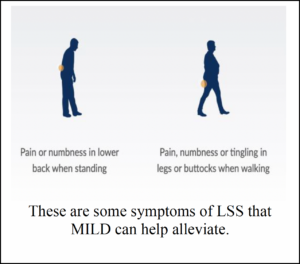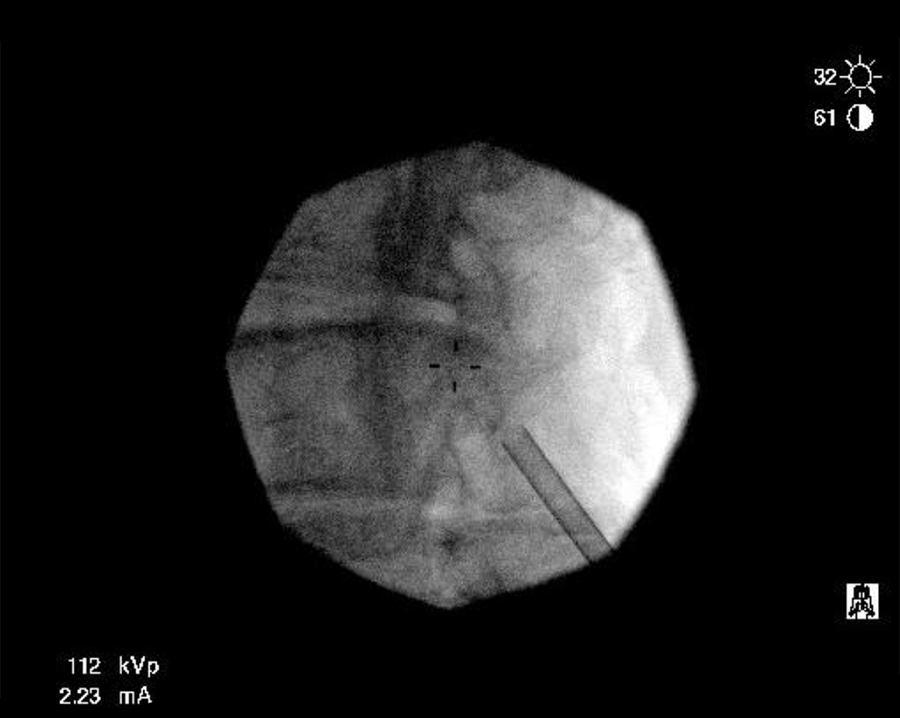What is MILD?
 Minimally invasive lumbar decompression – or more commonly known as MILD – is a procedure wherein a part of the ligament flavum tissue in the spine is removed due to excessive thickening. Excessively thick spinal ligaments cause the spinal canal to narrow, which puts pressure on the spinal nerves, leading to back pain and leg pain.
Minimally invasive lumbar decompression – or more commonly known as MILD – is a procedure wherein a part of the ligament flavum tissue in the spine is removed due to excessive thickening. Excessively thick spinal ligaments cause the spinal canal to narrow, which puts pressure on the spinal nerves, leading to back pain and leg pain.
What does MILD treat?
MILD is used to treat narrowing in the lower part of the spinal canal, or lumbar spinal stenosis (LSS). LSS is a degenerative condition that typically worsens with age and can cause pain, numbness, and tingling in the lower extremities. Patients also describe symptoms of neurogenic claudication (i.e., pain, numbness, and heaviness in the legs with standing). LSS can be treated with physical therapy, non-opioid pain medication, and lumbar epidural steroid injections. If these treatments do not adequately relieve pain, MILD, a minimally invasive procedure, might be an option for some patients before considering spine surgery.
The Procedure
 Basivertebral nerve ablation is a same-day outpatient procedure that involves radiofrequency ablation of the basivertebral nerve. The procedure is implant-free, preserves spinal structure, and requires a brief recovery period.
Basivertebral nerve ablation is a same-day outpatient procedure that involves radiofrequency ablation of the basivertebral nerve. The procedure is implant-free, preserves spinal structure, and requires a brief recovery period.
Under X-ray guidance, a probe is inserted into front of the spine (i.e. vertebral body) and placed at the trunk of the basivertebral nerve. Then, the nerve is heated via radiofrequency energy that is transmitted to the electrode tip of the probe. This heating process lesions the basivertebral nerve, reducing the transmission of pain signals. After the ablation, the probe is removed, and the procedure is complete.
It can take up to 4 to 6 weeks to experience the pain reduction benefit from basivertebral nerve ablation. However, many patients begin to experience relief earlier.
Why opt for the MILD?
 MILD is a brief outpatient procedure with low complication risk and quick recovery. Performed through a small incision, it allows patients to resume daily activities quickly. MILD effectively treats the root cause of LSS by addressing narrowing, providing pain relief and improved functionality. It can significantly reduce pain during activities like walking and standing, making it a viable option for treating LSS with minimal surgical risks and effective results in specific patients with hypertrophied ligamentum flavum.
MILD is a brief outpatient procedure with low complication risk and quick recovery. Performed through a small incision, it allows patients to resume daily activities quickly. MILD effectively treats the root cause of LSS by addressing narrowing, providing pain relief and improved functionality. It can significantly reduce pain during activities like walking and standing, making it a viable option for treating LSS with minimal surgical risks and effective results in specific patients with hypertrophied ligamentum flavum.
The Procedure
- Prior to the day of the procedure, the location of stenosis on the spine is identified via magnetic resonance imaging (MRI).
- On the day of the procedure, the patient lies face-down on the operating table and the back is cleaned with antimicrobial solution.
- Local anesthetic is administered. The patient receives light to moderate sedation.
- Location of stenosis on the spine is again confirmed via real-time x-rays.
- An incision smaller than the size of a baby aspirin is made on the skin and a thin portal is inserted through the incision to the spine.
- Surgical instruments are guided in through the portal, and with the help of real-time x-rays, the instruments are used to remove part of the laminar bone causing stenosis. Part of the ligamentum flavum, which is a special spinal ligament that supports the laminar bones, is also partly removed with some fatty tissue.
- X-ray will confirm decompression, after which the portal and surgical instruments are removed from the incision.
- The skin is then covered with a bandage.
- The patient is then observed in the recovery area.
- After a neurological exam, the patient is discharged and free to go home.

The image above shows a portal inserted into the skin above the spine.

The image above shows the portal instrument to place the surgical tools to remove the thickened ligament tissue from the spine.
Words to Know
 Ligament – fibrous connective tissue that attaches bones together.
Ligament – fibrous connective tissue that attaches bones together.
Ligamentum flavum – ligament in spine that attaches lamina (bones originating from vertebrae) together.
Stenosis – narrowing of the spinal canal which can lead to compression of the spinal cord or nerve roots sand subsequently lead to pain and functional dysfunction.
References
- Staats PS, et al. Long-Term Safety and Efficacy of Minimally Invasive Lumbar Decompression Procedure for the Treatment of Lumbar Spinal Stenosis With Neurogenic Claudication: 2-Year Results of MiDAS ENCORE. Reg Anesth Pain Med. 2018.
- Benyamin RM, et al. MILD® Is an Effective Treatment for Lumbar Spinal Stenosis with Neurogenic Claudication: MiDAS ENCORE Randomized Controlled Trial. Pain Physician. 2016.
- Hagedorn JM, et al. The incidence of lumbar spine surgery following Minimally Invasive Lumbar Decompression and Superion Indirect Decompression System for treatment of lumbar spinal stenosis: a retrospective review. Pain Pract. 2022.
- Mekhail N, et al. The durability of minimally invasive lumbar decompression procedure in patients with symptomatic lumbar spinal stenosis: Long-term follow-up. Pain Pract. 2021.
Contact form
Or just call (412) 221-7640 and we’ll do everything we can to help.
Across all review platforms
Dr. David Provenzano, a leading expert throughout the nation for treating patients who suffer daily from pain, uses advanced diagnostic techniques to assess the source of the pain and develop a comprehensive and safe treatment approach that can significantly reduce your pain.

